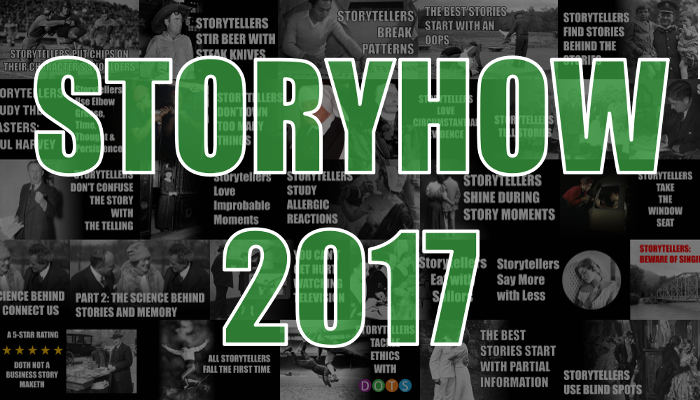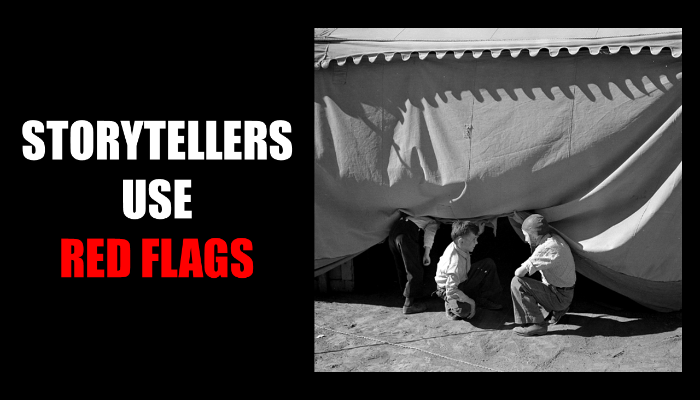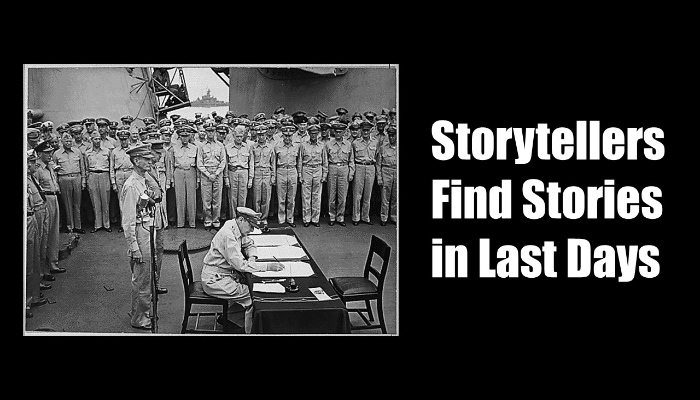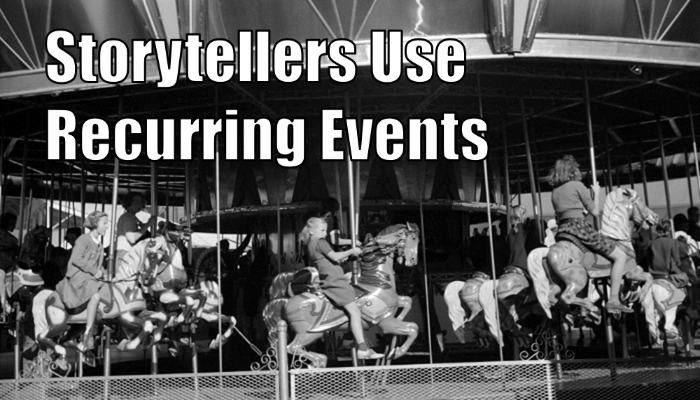by Ron Ploof | Dec 18, 2017 | Business Storytelling

Our goal at the StoryHow Institute is to be your go-to business storytelling resource by publishing strategies and tactics that you can use to become a better storyteller. We fulfilled that promise in 2017 through publishing the following 38 storytelling articles. We look forward to serving your storytelling needs in 2018.
1. Storytellers Put Chips on their Character’s Shoulders
The best storytelling lessons come from life. This one comes from NFL star Martellus Bennet.
2. Storytellers Stir Beer with Steak Knives
The most important skill that a storyteller can have is a keen sense of observation.
3. Storytellers Break Patterns
Our prior experiences hold an unfair advantage over our newer ones because they can cause us to react in seemingly incongruous ways.
4. The Best Stories Start with an Oops
Most companies dread mistakes. But the best stories tend to follow them.
5. Storytellers Find Stories Behind the Stories
Beginner storytellers are so focused on the primary story that they miss opportunities to add deeper meaning and memorability to them.
6. Storytellers Study the Masters: Paul Harvey
Master storyteller, Paul Harvey, not only dazzled audiences for over fifty years with his show The Rest of the Story, but he also proved the business value of a story.
7. Storytellers Use Elbow Grease, Time, Thought & Persistence
Most people think that the creative process requires waiting patiently for inspiration to strike. Glenn Frey, co-founder of the Eagles, learned that it required something else…work.
8. Storytellers Don’t Own Too Many Things
Beginner storytellers cram their stories with too many ideas, facts, threads, and characters. As a result, they’re forced to take care of those things, which draws time from the most important tasks, like serving their audiences.
9. Storytellers Study Foods that Begin with the Letter Q
Stories and the human memory are interdependent. Memories can’t work without stories and stories can’t work without memories.
10. Storytellers Love Circumstantial Evidence
Characters are the seeds of any story. Storytellers plant them in the fertile ground of circumstance and water the two with their individual wants.
11. The Only Way to Become a Storyteller is to Tell Stories
You can’t play the game by sitting on the sidelines. If you want to become a better storyteller, you’ve got to act the part.
12. Storytellers are Policy Wonks
What do robots and storytelling have in common? Policies, or the way each is encouraged to react in certain situations. Storytellers, like artificial intelligence researchers, put characters into situations, assign them policies, and see how they react.
13. Storytellers Don’t Confuse the Story with the Telling
It’s common for first-time storytellers to focus more on the story than the actual telling.
14. Storytellers Love Improbable Moments
Storytellers love improbable moments because odds-defying experiences break us out of our routines, make us pay attention, and therefore, frequently contain the seeds to some story.
15. Storytellers Study Allergic Reactions
Sometimes the words that we use can initiate strong reactions within people. That’s why storytellers study allergic reactions.
16. Storytellers Shine During Story Moments
Stories hinge on story moments–specific times when a character’s choice will alter the story’s trajectory–but not in the way that the audience expects.
17. Storytellers Take the Window Seat
Storytellers live in the moment, observing life and reflecting upon what they experience. They do so by putting themselves in the window seat.
18. Part 1: The Science Behind How Stories Connect Us
This science experiment demonstrates how our brains synch-up when we tell each other stories.
19. Part 2: The Science Behind Stories and Memory
The second of a two-part series that looks at the brain science behind storytelling. In Part #1, we saw how the brains of listeners and storytellers synchronize during the course of a story. This time, we watch people’s brains while they recall one.
20. You Can’t Get Hurt Watching Television
We all tell ourselves stories. In this blog post, Ron describes how one particular story convinced a man to remain focused on his job while bullets whistled by his head.
21. Storytellers Eat with Sailors
All stories are mysteries. Some are just bigger than others.
22. Storytellers Say More with Less
Most story novices think that story development starts by focusing on the big things like the plot, the struggle, and the final resolution. But, that’s not where the magic of storytelling resides. The best storytelling lives in the little details that hit audiences in the gut and make us feel a kinship with the characters.
23. Storytellers: Beware of Singing Bridges
Storytellers set believable hooks that satisfy audiences as opposed to stringing them along. Those that don’t will suffer the consequences.
24. A Five Star Rating Doth Not a Business Story Maketh
While 5-star reviews may make us happy, they aren’t very valuable from a business storytelling perspective. In this article, Ron examines the business value of the one, two, three, four, and five-star product review.
25. All Storytellers Fall the First Time
It doesn’t matter how much skill you have as a storyteller. Nobody can tell a brand new story without thinking about it first. And the science backs it up.
26. Storytellers Tackle Ethics with DOTS
Storytellers have an ethical responsibility to help their audiences. Simultaneously, storytellers must counterbalance that obligation by making stories interesting. So, where do they draw the lines? How do they choose which facts to use, omit, and modify while maintaining the integrity of the story? We suggest using DOTS.
27. The Best Stories Start with Partial Information
Great storytellers reveal just enough information to let an audience’s imagination run wild, before dropping one last piece of context that turns every assumption upside down.
28. The Creative Catalyst
Kip Meacham, Vice President of Marketing for CA Engineering, used his copy of the StoryHow™ PitchDeck so much, he wore out the box.
29. Storytellers Use Blind Spots
We all have blind spots–things that obstruct our ability to perceive the full scope of a situation. And they are very useful for storytellers.
30. The Best Story Tellers are Avid Story Students
The best way to learn storytelling is to immerse yourself in the work of others for a second, third or fourth time.
31. Storytellers Use Tools of Mass Induction
The best storytellers use techniques that keep their actively audiences involved in the story.
32. Storytellers Dole Out Information
Storytellers choose which information is released and who is privy to it.
33. Storytellers Use Anchors
Storytellers use anchors to set memories in the minds of their listeners.
34. Storytellers Use Recurring Events to Bond with their Audiences
Storytellers use recurring events (StoryHow PitchDeck Card #18) to anchor stories. They can be used to establish a historical foundation that can shape a story’s future. The best part is that audiences easily relate with them.
35. Storytellers Find Stories in Last Days
Last days signal change and all stories are based on change.
36. Storytellers Use Red Flags
Red flags are a special case of story statements. Use them well to pull audiences into your story.
37. Storytellers Chisel Stories out of Hidden Agendas1
Storytellers love hidden agendas because they form the chalk lines on story stones. Simply chisel along those lines and an interesting story emerges.
38. Storytellers Love Awkward Moments
We’ve all been there before–either experiencing a cringe-worthy moment or witnessing one. Storytellers love awkward moments because they’re not only filled with both internal and external conflict, but they are relatable to the audience.
by Ron Ploof | Dec 11, 2017 | Business Storytelling

I’d flown 3,000 miles to interview at a small, privately-held company. The first session took place over lunch with the CEO and CFO. They both described the need for a new business development manager. Since I’d worked with the CEO before, he wanted me to fill the role.
My next interview was scheduled back at the office with the engineering manager. Since he hadn’t returned from lunch yet, the CEO suggested that I sit at an empty desk and surf the web while I waited.
After about five minutes of surfing, a guy walked into office. Assuming that he was the engineering manager, I stood to greet him.
“Why are you sitting at my desk?” the man asked.
“Umm,” I stammered. “I was told to wait here?”
“Who told you that?” he barked.
I pointed toward the CEO’s office.
“Well, you can’t wait here,” he said, pushing me out into the hallway and closing the door behind him.
I stood there, stunned, wondering what had just happened. That’s when the engineering manager arrived and introduced himself.
“Nice to meet you,” I said. I pointed to the office that I’d been ushered out of. “Who’s that?”
“Oh, that’s our BizDev guy,” he said.
That confused me. “The BizDev Guy?” I could have sworn that the CEO and CFO had described the BizDev guy using the past tense–as in he’d already been fired. But, the farther I got into the interview with the engineering manager, the clearer my understanding became. The BizDev guy was unknowingly a dead man walking.
Before I left for the airport, I asked the CEO about his curious choice for my waiting area.
“Sorry about that,” he said unconvincingly. “We weren’t expecting him to be in the office today.”
I left feeling as if I’d just been used in some sadistic social experiment.

Storytellers love awkward moments because they’re filled with boundless possibility. Fueled by both internal and external conflicts, cringe-worthy situations offer much storytelling latitude. Listeners easily relate with awkward moments and have instant sympathy for those who are stuck in them.
Awkward situations work because they are uncomfortable for the characters and the audience. The same discomfort that makes us squirm in our seats is the same force that forges a memory deep into listeners’ minds to be recalled when we find ourselves in future awkward moments.
One of my biggest life regrets was taking that job. Blinded by the opportunity to bring my family to Southern California, I couldn’t see the early warning signs. I should have recognized the experience as a real-life foreshadowing moment. If the CEO was capable of such manipulation while on his best behavior, what was he capable of on his average behavior? I saw many more examples of this sociopathic behavior over the eighteen months that I could stomach the position.
Awkward moments are both relatable and memorable. They’re relatable because we’ve all been in uncomfortable situations before. They’re memorable because we tend to remember painful moments in our lives. So, the next time you’e looking for a story to tell, create a list of awkward moments that you’ve found yourself in. What did you learn from them? What might you have done differently? Did it prepare you for dealing with a future awkward moment? Perhaps this list will lead you to your next story.
Photo Credit: Detroit Publishing Co., Publisher. [Boy and Girl Seated in Rustic Arbor]. , None. [Between 1900 and 1920] Photograph. Retrieved from the Library of Congress, https://www.loc.gov/item/det1994022676/PP/.
by Ron Ploof | Dec 4, 2017 | Business Storytelling

A story is the result of people pursuing what they want.
Story possibilities are infinite because people want different things for vastly different reasons. Add the fact that most people rarely express what they actually want and we open up even more possibilities.
For example, let’s take two people in the midst of a negotiation. One wants to buy and the other wants to sell. Each party has two motivations: an external one (expressed) and an internal one (hidden). Storytellers delight in the combination and permutation opportunities of two people with four competing motivations.
Let’s get more specific about this negotiation.
Mitch and Jill must sell their midwest home because Jill has accepted a new job in Silicon Valley. While her new position comes with a significant raise, most of it will be eaten up by the Silicon-Valley-sized mortgage. Therefore, the more they can get for the house, the less they’ll need to pay on their new mortgage.
Jay, a lifelong renter, has finally saved enough to buy his first house. He’s decided not to renew his lease, so he must move out of his apartment by the end of the month. But, he’s in no rush. He can stay at his parents home while they’re wintering in Florida. Since he has no appliances, it’s important that they be included in the price of the house.
Can you see the multiple storyline possibilities of such a negotiation? The question is how to find which lines to chisel along.
- Tell it from Jay’s perspective and he and the reader can only know his motivations.
- Tell it from Mitch & Jill’s perspective and we can only know theirs.
- Tell it as the third-person omniscient (big word for a narrator who knows everything) and we have the ultimate control over Who Knows What (SHPD Card #43).
Storytellers love hidden agendas because they form the chalk lines on story stones. Simply chisel along those lines and an interesting story emerges.
The best stories are driven by mismatches between internal and external motivations. What are some of the hidden agendas within your industry? Perhaps they can be overlaid on your next story stone.
Photo Credit: Harris & Ewing, photographer. Wash. D.C. Chiseling on justice. Gino A. Ratti, carver, puts the finishing touches on “Contemplation of Justice,” installed at the entrance of the new U.S. Supreme Court building. J.E. Frasier is the sculptor. 11/22. Washington D.C, 1935. Photograph. Retrieved from the Library of Congress, https://www.loc.gov/item/hec2013009662/
by Ron Ploof | Nov 20, 2017 | Business Storytelling

Let’s try writing the beginning of a story.
It had been a long day. Sandy couldn’t wait to get home, change into comfortable clothes, and relax in front of the television. She pulled into her driveway and noticed the darkened front steps. ”That’s odd,” she thought. “Did that porch light burn out again?”
She fumbled with the lock in the darkness, but the door swung open before she could insert the key. She wondered whether she’d closed the door earlier that morning. Rather that thinking too much about it, Sandy entered the house and locked the door behind her.
Got it? So, what’s going on here? Is everything okay with Sandy? Do you have any concerns for her safety? If so, why? The bare facts don’t explicitly tell us that she’s in any danger. She might be walking into a safe empty home, a dangerous ambush, or a surprise party organized by her best friend.
Red flags are special story statements. They’re odd little facts that just don’t seem right. Did you wonder why the porch light was out or the front door was ajar? Storytellers evoke those questions using red flags. Red flags force listeners to anticipate uncertain future events and the listener’s mind will not rest until they’re answered.
Red flags draw audiences into the story. They help listeners care about the characters and have been known to make people in darkened movie theaters scream out, “Don’t go in there!” or “Don’t do it!”
Yet, it’s curious that few marketers ever use them–especially in success stories. Success stories are vehicles that marketers can use to help prospects get a feel for products and services. For example, here are some potential opening lines:
- Jered had estimated that his cell phone battery had at least an hour left on it.
- Monica wondered why the assets on the balance sheet were significantly lower than last week’s.
- Scott’s hard drive had been making an annoying clicking sound for the past two days.
Each line contains a red flag, something that the audience can relate with and the storyteller can build upon.
Are you wondering how to start a success story? Consider using a red flag.
Photo Credit: Rothstein, Arthur, photographer. Sneaking under the circus tent. Roswell, New Mexico. Chaves County New Mexico Rosewell, 1936. Apr. Photograph. Retrieved from the Library of Congress, https://www.loc.gov/item/fsa1998018640/PP/
by Ron Ploof | Nov 13, 2017 | Business Storytelling

I walked off the basketball court for the last time about four years ago. The old body just couldn’t keep up with not only with the young guys, but the multiple-day healing process. After sustaining serious injuries–one that required surgery–I knew it was time to hang up the high tops.

Last days are defining moments. Sometimes, we know they’re coming, such as the last day that we drive an old car because we are buying a new one; the last day of treatment for an illness; or the last time we use a product that’s being obsoleted. At other times, we experience a last day, unknowingly. Some are welcomed, such as the last day time we stubbed a toe, argued with a grumpy neighbor, or were forced to make a difficult decision. Other surprise last days aren’t always appreciated, such as when your favorite restaurant closes its doors unexpectedly, or your last day of gainful employment before being laid off.
Last days mark change–some of it good and some of it bad–but necessary nonetheless. Without the death of one thing, there can’t be the birth of another. As the display case in Harvard University’s Caspersen Room says: “Out of the ould fields, must spring and grow the new Corne.”
Last days mark change and all stories are based on change. They form the backbone of the great story of life. The bigger the change, the better the story. If nothing changes, however, what remains is a non-story collection of narrative facts.

Basketball has played an important role in my life and I needed to replace it with something. Luckily, I live at the mouth of a wilderness park with steep hills and lots of trails. I now explore those trails. And while my daytime treks aren’t as exciting as a two-on-one breakaway, or defending a full-court press, I find that they offer quiet time to think, reflect, and to develop more stories.
So, what are some of the last days in your industry? Career? Perhaps you can use them in a story. Tell us about the last time you know it was a last day. Or, tell us about a customer’s last day, yet they didn’t know it at the time. All of these last days are the beginnings of new stories.
Photo Credit: National Archives. General Douglas MacArthur signs as Supreme Allied Commander during formal surrender ceremonies on the USS MISSOURI in Tokyo Bay. Behind General MacArthur are Lieutenant General Jonathan Wainwright and Lieutenant General A. E. Percival.
by Ron Ploof | Nov 6, 2017 | Business Storytelling

I first attended the Design Automation Conference (DAC), an annual trade show for electrical engineers, in the late 1980s. DAC is to engineers as Comicon is to cosplay fanatics. At that time, few people had PCs, fewer had Internet access, and the concept of a portable device involved putting an extra long cord onto your wall-mounted kitchen phone. DAC attendees have had front row seats to the information revolution–getting to see the birth of the semiconductor technologies that ultimately led to the devices that we use everyday.

Life is cyclical. Every year has twelve months and four seasons. We celebrate certain days like New Years, Valentines, Memorial, 4th of July, Labor, Thanksgiving, and Christmas. We mirror that cycle in our professional lives with product life cycles, quarterly results, and weekly reports.
Storytellers use recurring events (StoryHow PitchDeck Card #18) to anchor stories. They’re used to establish patterns that storytellers can use either to set-up future problems or offer ways to solve them. They establish a historical foundation that can shape a story’s future. The best part is that audiences relate with recurring events, even bonding with them on an emotional level (Memorial Day) or a professional level (annual conferences).
The strength of recurring events comes from the fact that although they appear identical, the situation never is. No matter how many New Year’s Days we celebrate or quarterly earnings calls we attend, we enter each occurrence as a different person. We’re one year older or one quarter wiser, and thus we experience the event in a different way.

2018 marks DAC’s 55th anniversary. If I attend this year, it will be very different than when I attended in my thirties, forties, and now in my fifties. DAC is a constant recurring event in a rapidly changing world–a life preserver if you will, in in a turbulent ocean of change.
What are some of the recurring events in your industry? Do they lend themselves to being a story starting point? An ending point? A time to reflect? Perhaps you can build your next story around one?
Photo Credit: Delano, Jack, photographer. The merry-go-round at the Rutland Fair, Vermont. Rutland Vermont, 1941. Sept. Photograph. Retrieved from the Library of Congress, https://www.loc.gov/item/fsa1998009101/PP/.





